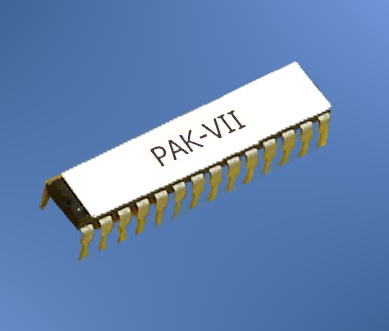
AWC Electronics - Pulse Input

The PAK-VII provides 8 channels of pulse input. You can read the width of the last high or low pulse on each channel (16 bits at up to 5uS resolution). You can also read a count of rising or falling edges on each channel. As a bonus, you can also use the PAK-VII to keep track of time in 200mS or 1 second intervals. Of course, you can also just read the current state of the 8 inputs if you like.
Use the PAK-VII to:
- Monitor push button switches without polling
- Measure frequency and duty cycle of square waves
- Keep an accurate real-time clock, even on a Basic Stamp
- NEW: Read quadrature sensor inputs
The PAK-VII uses our time-tested PAK protocol (similar to the PAK-I, II, III, and IV). With the Basic Stamp, you'll simply use ShiftIn and ShiftOut to communicate with the chip. You only need two pins to connect the PAK. Plus you can share those two pins with most other PAKs if each PAK has a separate enable pin.
The PAK-VII is easy to use. There are only 3 commands: one command reads the registers that contain the counts and time measurements, another resets all counters. The final command allows you to set a prescaler value to accommodate long duration pulses. The PAK-VII's example Basic Stamp library lets you get started using the chip right away.
The Details
With the PAK-VII you receive the PAK-VII chip, a ceramic resonator, and a data sheet that explains how to use the chip (read it here).
Each input channel has a set of 6 16-bit registers that store the pulse widths and counts. When you read a register, you can clear it, or you can clear all the channel's registers. At the default clock speed, the maximum pulse width readable is about 325mS (note: longer pulses will still correctly set the edge count registers). The maximum number of edges the chip can count is, of course, 65535. Of course, you can read the counts, reset them, and accumulate more counts in the host microcontroller if necessary.
The PAK-VIIb is a 28-pin device. You can clock the PAK-VIIb to 75MHz for higher timing resolution if desired.
Need pulse output? Check out the PAK-VIII
Get it Now!
Try a PAK-VII for 21 days. If you aren't delighted, just send it back undamaged for a full refund of your purchase price. But once you see your Stamp measuring pulses so easily, you won't want to be without it.
Add to Cart PAK-VIIb Coprocessor $24.95 each (28 pin)
Note: The PAK-VIIb has replaced the PAK-VIIa and is recommended for new designs. If you need a PAK-VIIa, please contact us.
Key Benefits
Saves development timeCounts and measures pulses continuously
High resolution measurement of frequency and duty cycle
Perfect for tachometry
Reads quadrature
Can also be used as a time base
Key Links
Site contents © 1997-2018 by AWC, Houston TX (281) 334-4341